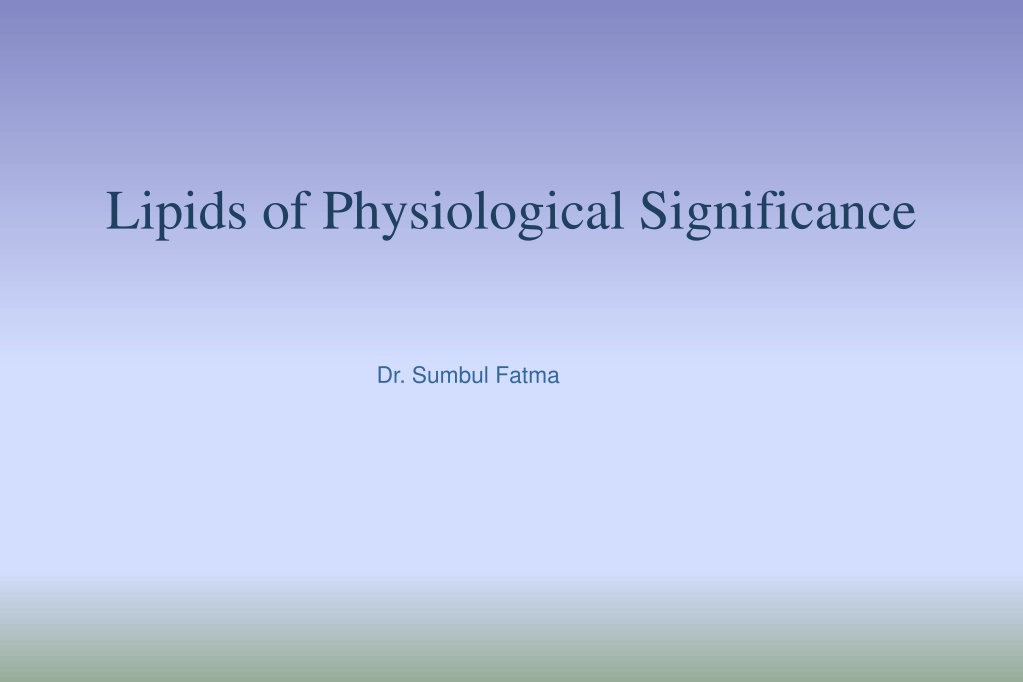Understanding the Significance of Lipids in Physiology
Explore the world of lipids, their classifications, physiological importance, and implications in clinical conditions. Understand the functions of simple and complex lipids, their role in energy storage, cell signaling, and disease associations. Dive into the diverse functions and classifications of lipids, including fatty acids and their unique properties. Learn how lipid metabolism is linked to diseases like atherosclerosis, coronary artery disease, obesity, metabolic syndrome, and hypertension.
Download Presentation

Please find below an Image/Link to download the presentation.
The content on the website is provided AS IS for your information and personal use only. It may not be sold, licensed, or shared on other websites without obtaining consent from the author. Download presentation by click this link. If you encounter any issues during the download, it is possible that the publisher has removed the file from their server.
E N D
Presentation Transcript
Lipids of Physiological Significance Dr. Sumbul Fatma
Objectives By the end of this lecture the first year students will be able to: Define and classify lipids Understand the physiological importance of lipids List the examples of simple and complex lipids Correlate implications of lipids in clinical conditions
Overview What are lipids? Classification of lipids Functions of lipids Simple lipids: Fatty acids, triacylglycerols, steroids Complex lipids: Phospholipids, sphingolipids, glycolipids Plasma lipid transport: types and functions of lipoproteins
What are lipids? A heterogeneous group of hydrophobic (water- insoluble) organic molecules that are soluble only in organic solvents Body lipids are compartmentalized (packed) in cell membranes, tissue and plasma
Functions of Lipids Lipids are essential components of biological membranes Lipids with hydrocarbon chains serve as major energy stores Cell signaling involves lipid molecules e.g. Inositol tri-phosphate Fat-soluble vitamins, steroid hormones and prostaglandins are formed of lipids
Lipids and disease Diseases that are strongly associated with abnormality in lipid metabolism: Atherosclerosis Coronary artery disease Obesity Metabolic syndrome Hypertension
Classification of Lipids Simple lipids: Fatty acids Triacylglycerols Steroids (cholesterol) Complex lipids Phospholipids Sphingolipids Glycolipids
Fatty Acids (FAs) FAs are carboxylic acids with long-chain hydrocarbon side groups They are amphipathic in nature (both hydrophilic and hydrophobic) The carboxylic group (COOH) is hydrophilic The hydrocarbon chain is hydrophobic
Fatty Acids (FAs) FAs are highly insoluble in water Must be transported in plasma with proteins Majority of plasma FAs are esters of: Triacylglycerol Cholesterol Phospholipids Chain length In mammals it varies from C16 C18 Examples: palmitic, oleic, linoleic, stearic acids
Fatty Acids (FA) Degree of saturation FAs may contain: No double bonds (Saturated / trans form) One or more double bonds (Mono or Polyunsaturated / cis form)
Saturated FAs Unsaturated FAs 12:0 Lauric acid 18:1 Oleic acid 16:0 Palmitic acid 18:2 Linoleic acid 18:0 Stearic acid 20:4 Arachidonic acid 16:0 20:4 No. of carbon atoms Zero double bonds No. of carbon atoms Four double bonds
Essential Fatty Acids (FA) Linoleic acid (precursor of arachidonic acid) -Linolenic acid Body cannot synthesize Must be supplied in the diet Deficiency can cause dermatitis, membrane function loss Arachidonic acid is essential when linoleic acid is deficient in the diet
-3 and -6 fatty acids = Omega Long-chain polyunsaturated FAs with first double bond starting with 3rd carbon from the methyl end They reduce serum triglycerides, blood pressure and risk for heart disease Major source: Fish Examples: -linolenic acid, EPA (eicosapentaenoic acid), DHA (Docosahexaenoic acid)
-3 and -6 fatty acids Long-chain polyunsaturated FAs with first double bond starting with 6th carbon from the methyl end They reduce serum cholesterol Major source: Vegetable oils, nuts Examples: Linoleic acid 18:2
Triacylglycerols (TGs) TGs are tri-esters of fatty acids also called fats Three fatty acids are bonded to a glycerol molecule Constitutes majority of dietary lipids Stored in adipocytes (fat cells) as energy reservoir Not a component of cell membranes Subcutaneous layer of fats provides thermal insulation
Steroids Derivatives of cyclopentanoperhydrophenanthrene ring Consists of four fused rings called steroid nucleus with an 8-carbon chain Steroids with a hydroxyl group are called sterols Cholesterol is a major sterol in humans and animals Cholesterol in plasma is bound to fatty acids called cholesteryl esters
Functions of cholesterol Component of cell membranes Precursor for: Bile acids / Bile salts Vitamin D Steroid hormones (Aldosterone, cortisol, testosterone, estrogen, progesterone) High levels of plasma cholesterol is strongly associated with coronary artery disease and atherosclerosis
Phospholipids Two classes of phospholipids: Glycerophospholipids (contain glycerol backbone) Sphingophospholipids (contain sphingosine) Glycerophospholipids Glycerol-3-PO4 is bonded to two fatty acid chains The PO4 group is linked to a hydrophilic group Amphiphilic in nature Hydrophobic tail Hydrophilic phosphoryl heads
Glycero- phospholipids
Phospholipids Major components of biological membranes Examples: phosphatidic acid, phosphatidyl choline and serine Sphinogophospholipids Long-chain fatty acids attached to sphingosine Example: Sphingomyelin An important component of myelin that protects and insulates nerve fibers
Glycolipids Contain both carbohydrate and lipid components Derivatives of ceramide A long chain fatty acid is attached to sphingosine Also called glycoshpingolipids Examples: Ganglioside, glactocerebroside Act as: Blood group antigens, cell surface receptors for bacteria/viruses
Transport of plasma lipids Plasma lipids are transported as lipoprotein particles (lipids + protein) Protein part: Apoproteins or apolipoproteins Examples: Apolipoproteins A, B, C Functions: lipid transport, enzymatic functions, ligands for receptors Lipid part: Contains lipids of various types
Types and functions of lipoproteins Lipoprotein Transports Chylomicrons Dietary TGs Very low density lipoprotein (VLDL) Endogenous TGs Low density lipoprotein (LDL) Free cholesterol High density lipoprotein (HDL) Cholesteryl esters
Take home message Lipids are a group of hydrophobic molecules Perform essential physiological functions in the body Simple lipids include: fatty acids, TGs and steroids Complex lipids include: phospholipids, sphingolipids and glycolipids A number of diseases are associated with abnormal lipid metabolism
References Lippincott s Illustrated Reviews, Biochemistry, 6th edition, Denise R. Ferrier, Lippincott Williams & Wilkins, USA. Chapter 16: pages 181-182, 195-198 Chapter 17, page 201-202, 205-206 Chapter 18, page: 219-220, 226-232


 undefined
undefined





















